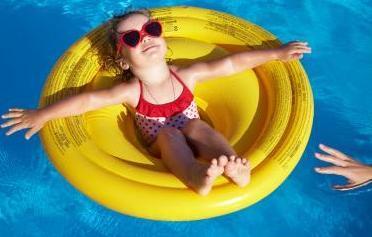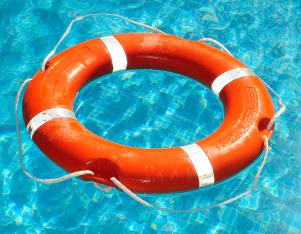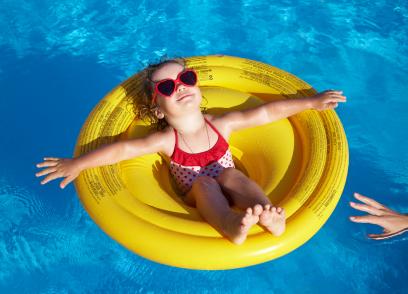 Although swimming pools offer a relief from summertime heat, they also present considerable risks–especially for the young.
Although swimming pools offer a relief from summertime heat, they also present considerable risks–especially for the young.
The Consumer Product Safety Commission and the Insurance Information Institute warn swimming pool owners to keep in mind the safety and insurance issues they present.
Drowning is the leading cause of unintentional deaths in the U.S. for children aged five and under, according to the CPSC. About 5,200 pool or spa-related emergency department-treated submersion injuries occur on average each year for children younger than 15.
Because of this, the commission is running a national Pool Safely campaign to increase awareness. Any potential pool hazard not only puts lives at risk, it also brings a financial exposure for the owner.
“You can be sued if someone drowns or is injured in your pool even if they did not have your permission to be there,” Jeanne M. Salvatore, senior vice president and consumer spokesperson for the I.I.I., said in a statement. “So it’s important to have the proper locks and safety equipment and to have appropriate liability insurance.”
For anyone who owns a swimming pool, or is in the market for one, the I.I.I. recommends taking the following steps:
• Notify the insurance agent or company representative
• Let your insurance company know about the pool as it will increase liability risk. Pools are considered an “attractive nuisance” and additional liability coverage could be needed.
• Pool owners might consider increasing the $100,000 minimum in a homeowners policy to at least $300,000 or $500,000. They can also buy an umbrella liability policy which, for an additional premium of $200 to $300 a year, gives $1 million of liability protection over and above a standard homeowner’s policy.
“Pools offer a great way to keep cool in this heat and humidity, but they can also be dangerous,” Salvatore said. “A child can drown in a few inches of water in less than 30 seconds.”
 An expensive pool will need enough insurance protection to replace it in the event it is destroyed by a storm or other disaster.
An expensive pool will need enough insurance protection to replace it in the event it is destroyed by a storm or other disaster.
Any deck furniture around the pool should also be considered when calculating the replacement value of the pool.
Each town will have its own definition of what constitutes a ‘pool,’ often based on its size and the depth of the water. If a pool meets that definition, owners must comply with local safety standards and building and electrical codes. This may include installing a fence of a certain size, locks, decks and pool safety equipment.
To help spread the word about the importance of pool safety, the I.I.I. is partnering with the CPSC for the third year of its Pool Safely public education campaign (also on Twitter: @poolsafely).
“Pools offer a great way to keep cool in this heat and humidity, but they can also be dangerous,” Salvatore said. “A child can drown in a few inches of water in less than 30 seconds.”
Keep children and other pool users safe by taking these precautions:
• Create several “layers of protection.” In other words, set up as many barriers as possible to the pool area, in addition to the fences that are often required by towns and municipalities.
• Never leave toys or floats in the pool when it is not in use—they can be a deadly temptation for toddlers who might fall into the pool when trying to reach them.
• Check the pool area regularly for glass bottles, toys or other potential accident hazards.
• Keep CD players, radios and other electrical devices away from pools or nearby wet surfaces.
• Limit alcohol use around the pool as drinking alcoholic beverages negatively impacts balance, coordination and judgment—and its effects are further heightened by sun exposure and heat.
• Clearly post emergency numbers on the nearest phone, so they can be located easily in the event of an accident.
In addition, Pool Safely recommends the following:
• Watch Children in and Around the Pool
• Never leave a child unattended in a pool or spa and always watch children closely around all bodies of water.
• Teach children basic water safety tips.
• Keep children away from pool drains, pipes and other openings to avoid entrapments.
• Have a telephone close by when using a pool or spa.
• If a child is missing, look for them in the pool or spa first.
• Share safety instructions with family, friends and neighbors.
• Learn water safety skills
• Learn how to swim and teach the children how to swim.
• Learn to perform CPR on children and adults and update those skills regularly.
• Understand the basics of life-saving, to provide assistance in a pool emergency.
• Have proper pool or spa equipment
• Install a four-foot or taller fence around the pool and spa and use self-closing and self-latching gates; ask neighbors to do the same at their pools.
• Install and use a lockable safety cover on a spa.
• If the house serves as a fourth side of a fence around a pool, install and use a door or pool alarm.
• Maintain pool and spa covers in good working order.
• Ensure any pool and spa has drain covers that comply with federal standards and ask a pool service provider if unsure.
• Have lifesaving equipment such as life rings, floats or a reaching pole available and easily accessible.












